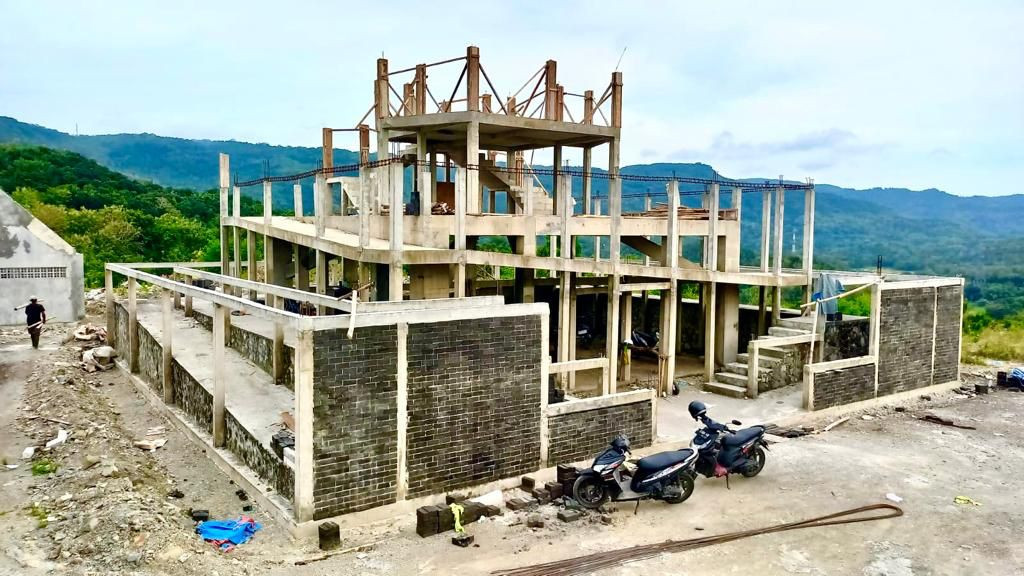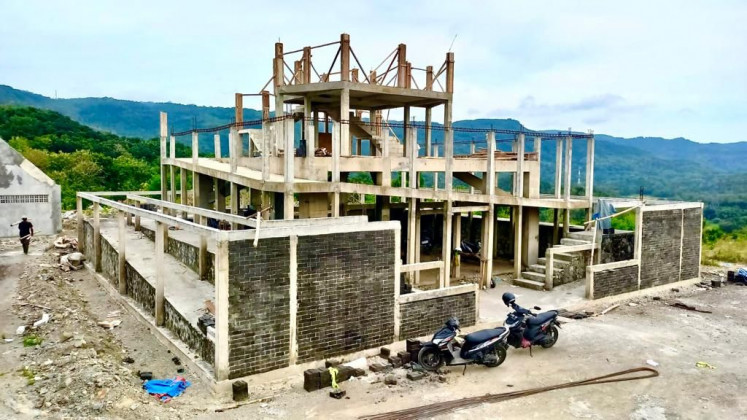Popular Reads
Top Results
Can't find what you're looking for?
View all search resultsPopular Reads
Top Results
Can't find what you're looking for?
View all search resultsWaste and cultural wonders: Yogyakarta artists put the city’s landfill on the map
While the monument itself is a response to the Anthropocene, the current, human-impacted geological epoch, the top is dedicated to hope for a more harmonious world.
Change text size
Gift Premium Articles
to Anyone
I
n a region known as the heart of Javanese culture because of its temples and nature, the idea of decomposing food waste and discarded packaging seems almost taboo.
Yet Yogyakarta’s waste problem is vast.
Each week, around 800 tonnes of waste enter Piyungan TPA, the region’s landfill site, and it frequently closes with the explanation being it has reached overcapacity. The regional administration is planning to expand the site’s current 12.5 hectares, the equivalent of 12 soccer pitches, by another 5.8 ha by 2024.
A collective of artists, activists and architects, in partnership with Germany’s Goethe-Institut, the Indonesian Upcycle Forum and the Bantul administration are attempting to find a holistic solution to this trash crisis, with a simultaneously spiritual, artistic and scientific response.
The team is building Monumen Antroposen, a temple-like structure situated within the landfill site. Drawing on ideas of the circular economy and ancestral practices, this ambitious project is hoped to be a new cultural landmark for the region, rooted in the history of Piyungan and built of bricks made from the city’s compressed waste. The soft opening is on July 29.
“Here, we’re hoping we can come back to an era where there is harmony between humans, ancestors, nature and God, but in a new version that is more up to date, that is digital,” initiator Iwan Wijono, artist and Indonesian Upcycle Forum member, said when The Jakarta Post came for a site visit on June 19.
In the past, Iwan said, the circular economy was found naturally in Indonesia. Farmers’ waste was used as fertilizer, uneaten food was for livestock, fishpond water was used for plants. “Nothing was thrown away. Nature was our teacher because nothing became rubbish.”
But communities have become disconnected from nature as society hurtled toward an urban, capitalist lifestyle, spurred by colonialism “cutting cultures from their roots,” according to fellow initiator Franziska, a German-born artist and member of the forum.
With the combined cultural space and experimental brick-making facility, they see the monument as a prototype for open-source technology, so in the future, rubbish collectors and bank sampah (waste banks) around Yogyakarta can make and sell their own bricks.
Coming full circle
Drive through the gates of Piyungan TPA, past the cows gently grazing on the trash to the border with Bawuran village, and the towering, 335 square-meter construction comes into view. To the left are buildings for art, community and research projects, as well as rooms for sorting waste and making bricks.
Inspired by Sukuh temple in Surakarta, Central Java, and Mayan temples in Central America, the team involved archaeologists and spiritual leaders in the design and location of the monument – a flat-topped pyramid comprising three levels, each with a relief depicting the stages of humankind’s impact on Earth.
While the monument itself is a response to the Anthropocene, the current, human-impacted geological epoch, the top is dedicated to hope for a more harmonious world.
“In the beginning, what drew me [to the project] was more the material. I still didn’t understand anything about the circular economy, but as an architect, the idea of creating alternative building materials was exciting,” Monumen’s architect Dhoni Yudhanto explained.
The black, volcanic-rock looking bricks are made of plastic that is currently difficult to recycle, such as bottle labels, cigarette packaging or single-use bags. From 5 to 6 kilograms of waste, the team can produce a 3-kg brick through the process of heating and compression.
The monument will need around 50,000 bricks, consuming around 300 tonnes of plastic. “This actually is only a small amount if we compare it with the amount of waste that is created every month in Yogyakarta,” Dhoni said. “I received information that just last week, Yogyakarta produced 300 tonnes [of nonorganic waste].”
“And that’s just the waste that actually enters [Piyungan],” Iwan interjected.
Yet despite the amount of waste coming in each week meeting the brick demands, with construction having started in October 2021 and currently around 50 percent finished, progress has been slower than the team first anticipated, primarily because it has been challenging to actually source the waste.
Construction of Monumen Antroposen in Yogyakarta’s Piyungan TPA landfill site on April 12, 2023. (-/Franziska Fennert)Economies of waste
“Perhaps not many people know that waste management is a business,” said Ignatia Nilu, art curator and writer.
What may at first seem like a place for merely dumping, in Piyungan all waste has a value, with the plastic collected by the sorters going through a tightly managed chain of buyers.
As “outsiders” coming into the landfill ecosystem, at first the community was suspicious, “Waste is already a business, it is already solid, and here we were as artists trying to come into this space.” Nilu said. In the beginning, many thought it was just a project for momentary economic activity.
Another challenge was because the plastic they were searching for did not already have a market, the price given to them varied wildly: “If we go to the waste depots or the bank sampah, plastic bags can be just Rp 800 per kilo [around half a US cent], but somewhere else it can be Rp 3,000 per kilo, Rp 4,000, Rp 8,000 per kilo,” Dhoni said.
The team also visits local markets to collect the valueless waste. Sometimes, if sellers knew they needed it they would raise their price – it has turned into an expensive project.
Despite the waste industry providing livelihoods for the waste sorters, only a small percentage of the waste is properly processed.
“In the end, so much waste is just covered with soil,” Nilu explained.
So the team has been embarking on a long-term project, beginning all the way back in October 2020, to build relationships with the local community and government through tours, discussions, film screenings and cultural events.
Trash talk
“The spread of awareness has been pretty organic. The [building team] would go home and tell their wives, tell their children, their neighbors: ‘I made bricks out of rubbish today’ and these small stories would spread”, Altianta, who heads the project’s foundation said, sharing that many of the team had started asking if the bricks were ready to use for their own homes.
Monumen Antroposen is working with the National Research and Innovation Agency (BRIN) to conduct a life-cycle assessment, making sure the bricks are safe for humans and the environment long term, beginning “from the sorting [of the waste] to the implementation,” explained Franziska. The team hopes to standardize the bricks for commercial use.
Dhoni, reflecting on the future, shared that, “we know in Jogja there are already hundreds of activists, artists and scientists who are making movements with the concept of rubbish. But they are working individually. Here we want to make a hub so that these different groups can meet, discuss and in the end, we can find solutions.”
For Altianta, the project represented a new marker of civilization, in a region whose historical significance is being overtaken by rubbish.
“There is Prambanan temple over there, there is Boko temple over here, maybe there will now be this contemporary monument added to the map too,” he said.











